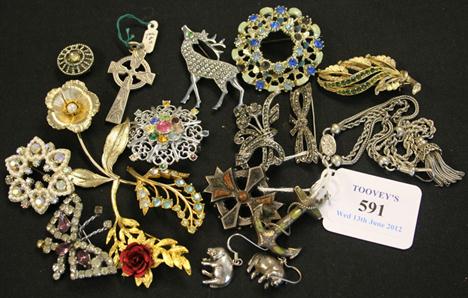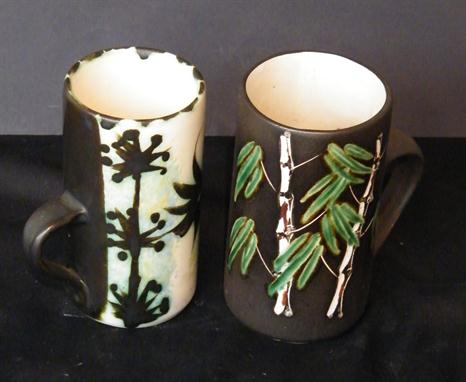We found 32564 price guide item(s) matching your search
There are 32564 lots that match your search criteria. Subscribe now to get instant access to the full price guide service.
Click here to subscribe- List
- Grid
-
32564 item(s)/page
An African Sword, the broad double edge steel blade widening towards the tip, with baluster ebonised wood grip and large broad two piece wood scabbard carved with a celtic knot device, bound with cane and with plaited grass strap; an African Short Sword, with hide bound grip; an African Throwing Knife, with sickle shape blade (3)
John Leone, American 1929-2011- Three jockeys on horseback; oil on board, signed, in a reverse profile hand made gilt composition frame with celtic inspired tooling detail and rope twist back edge, 61x76cm: together with another oil on board by the same artist depicting a jockey and trainer on horseback, signed, in a reverse profile hand made gilt composition frame with geometric tooling decoration, 51x61cm, (2)
A silver and Connemara marble brooch designed as an anchor, a Scottish style vari-coloured stone set brooch, a silver and marcasite set brooch designed as a bow, ten costume brooches, a dress Albertine with a tassel drop, a pair of earrings designed as pigs, detailed `925`, a silver pendant cross in a Celtic design, Birmingham 1926, and two further items.
An extensive Celtic Point canteenCharles W Fletcher, mainly London 1915, of slender Celtic Point pattern with engraved stags head crest to terminal, comprising eighteen tablespoonstwelve table forksthirteen dessert spoonsforty one dessert forksfourteen teaspoonsthirty coffee spoonstwelve icecream spoonstwo sugar tongsone butter knifetwo sauce ladlesone fish servertwo ladles (qty)approx 185oz
Louis Le Brocquy HRHA 1916-2012 DISTANT IMAGE Oil on canvas, 57 1/2" x 45" (146 x 114.2cm), signed and dated 1970 verso. In the late 60`s and early 70`s, Irish art was going through a pivotal change, and Louis Le Brocquy was an integral part of this changing landscape. In the early 1960`s Louis le Brocquy was going through a difficult time, much like a writer who has experienced `writers block`. In 1964, he visited the Musée de l`Homme, where he saw ancestral Polynesian clay skull heads with cowrie shells for eyes. These heads were similar to the Celtic head, the embodiment of the human being, which sparked an interest in Celtic art and culture unleashing a flood of ideas and conjuring up the artist`s vivid sense of loneliness of the Paleolithic man, lacking any known past and therefore any conception of his future. In 1969, Northern Ireland was rocked by intense political and sectarian rioting which developed into the" Troubles." Le Brocquy`s terrified heads of the early 70`s express this horror with a hand turned palm outwards ordering a halt to this sustained war Executed in 1970, "Distant image" with others of similar themes "Northern Image, 1971"(private collection) depict the anguish and suffering of the people in Northern Ireland. In "Distant Image", the effect of a face emerging slowly in the distance within two delineated squares evokes different emotions from each viewer. In the peering head, dappled red and blue pigment in the outstretched hand and cheekbones add drama to the floating image. The ghostly head is a human form with it`s flickering of flesh colour, isolated in a cloudy substance, eyes tight shut, mouth open aghast, as if suspended, perhaps trapped, perhaps blinded by a watery mist. The viewer waits for the mist to pass, for the face to change to a warmer skin tone, for the palm to turn and beckon us in a welcoming gesture, and in doing so, perhaps the image will submerge complete with eyes wide open, mouth smiling. In 1981, Dorothy Walker wrote a biography of the artist, and Le Brocquy spoke about his head series "For over fifteen years I have tried to draw from the depths of paper, or from the white canvas, a human face. As I have remarked, this quiet activity has little to do with communication, or with self-expression for that matter. It aims rather to make visible, a lurking image, to identify, to name some trace or aspect of reality…"(quoted by Dorothy Walker, a Biography, 1981 published by Ward River Press, p.146) There is no doubt that this is a major work by one of Ireland`s most distinguished artists.
A rare Liberty’s terracotta Floralis pattern sundial, designed by Archibald Knox circa 1905 stamped designed and manufactured by Liberty’s & Co. the plate also signed 107cm.; 42ins high It is extremely rare to find a sundial plate also signed by Liberty’s. Exotic terracotta garden pottery , designed by both Archibald Knox, who was Liberty’s chief designer and Mary Watts of the Compton Pottery were offered for sale in Liberty and Co’s Yuletide Gifts catalogue of 1903-4. In 1899 Archibald Knox began designing for Liberty particularly the new Celtic design work such as Cymric’ and ‘Tudric’ range. Their Cymric catalogue states, |The feature of this development is, its complete breaking away from convention in the matter of design treatment|. In addition to metalwork and jewellery Knox designed terracotta garden ornaments, carpets, wallpaper and fabrics for Liberty & Co, seemingly mastering each discipline with ease. He was held in such high esteem that, even after his association with Liberty & Co had ended, in 1917 he was commissioned to design the headstone for Arthur Lasenby, the founder of Liberty’s grave where it still stands at Lee, Buckinghamshire. Literature; See Archibald Knox & Mary Seton Watts, Modern Celtic Art Pottery , 2005 for an identical sundial, page 35 see additional illustrations
Various antique silver items, comprising ornate circular mother of pearl brooch, ornate oval locket, marcasite humming bird brooch, ornate brooch set with green stone to centre, marcasite set frame, marcasite set rings (2), one with stone missing, an ornately patterned Celtic cross pendant, slight dents to back & an ornately patterned cross pendant, stamped, tested or h/m (1.08oz) (8)
Louis le Brocquy HRHA (1916-2012) THE TÁIN COLLECTION Aubusson tapestry; Atelier René Duché (each no. 4 from an edition of 9) signed with initials in the weave on reverse by maître-lissier, René Duché and numbered lower right; with certificate of authenticity sewn on reverse, signed, numbered, titled and dated by le Brocquy and Duché 72.50 by 110in. (184.15 by 279.40cm) Provenance: Agnew`s, London; Where purchased by the current owner Exhibited: `Louis le Brocquy Aubusson Tapestries`, Agnew`s, London, 3-29 May 2001, The Táin Tapestries Louis le Brocquy was living in France with his young family when he received a life-changing invitation, in December 1966. Publisher Liam Miller wanted him to collaborate with Thomas Kinsella on a new translation of Ireland`s oldest saga. Le Brocquy penned an enthusiastic affirmative that Christmas Eve and spent much of the next three years visualising An Táin Bó Cúailgne. In September 1969, Dolmen Press published it as The Táin. The Táin was born of some eighty stories about the Ulaidh, a prehistoric people who lived in the north and north-western regions of what is now called Ireland. Part epic, part soap opera, the tales were vivid, vicious, inconsistent and often rather rude. Oral versions survived for long enough to be collected by scribes, whose fragmentary manuscripts are now in Trinity College and the Royal Irish Academy. Translators and writers such as Lady Gregory and W.B. Yeats had retold some of the Cúchulainn tales - and Joyce`s Finnegans Wake drew on its meandering style - but Thomas Kinsella`s Táin was the first widely-accessible version, especially when Oxford University Press` 1970 paperback followed the de luxe and limited editions produced by Dolmen Press. The Táin marked a unique cultural moment, for Ireland and the world. The State had just celebrated the 50th anniversary of the 1916 Rising and was driving ahead with Seán Lemass` Second Programme for Economic Expansion. By 1969 when it was published, Northern Ireland was in conflict, and global events such as the Prague Spring, the assassinations of Martin Luther King and Robert Kennedy, as well as wars in Vietnam, Angola and elsewhere, underlined its themes of invasion and carnage. Meanwhile, The Beatles sang "All You Need is Love." Its impact was instant. Although characters like Cúchulainn and Ferdia, Medb and Aillil, were local, the collaborators translated them into a crisply contemporaneous style that resonated through the cultural hierarchy. It engaged lovers of art, language, music and Celtic studies, as well as popular culture. The Táin became an Irish Iliad, with Cúchulainn as a Superhero reincarnating to a new age of rock, cartoons and animation. The images le Brocquy called `shadows thrown by the text` became so iconic that it is almost impossible now to imagine The Táin differently. Yet no one had visualised the full saga previously and no artist from Ireland had engaged so thoroughly with pieces of writing in so collaborative a way. Le Brocquy made hundreds of drawings, many of which appear in the de luxe and limited editions, with a handful printed in the paperback and a precious twenty in these tapestries. Communication was difficult in those pre-digital days because he was in France and Miller was in Dublin, so that many key design decisions relied on sending letters through the post. Le Brocquy`s innovative, daring approach cast the saga as a virtual alphabet composed of spontaneous, inky letters. This shows immediately in Army Massing, where marks cascade in rivulets that resemble both chain mail and hand-writing, and in the H-shaped Cúchulainn confronting Ferdia. Different ages and cultures whisper through the images - and through these twenty tapestries made during 1998-2000, when le Brocquy collaborated with maître-lissier René Duché, whose firm had recently been awarded the honour Meilleur Ouvrier de France. Cuchulainn`s Warp Spasm, for example, speaks both of calligraphic marks from Sun Tzu`s The Art of War and Yves Klein`s bodily-marked Anthropometries, as well as cave paintings traced by prehistoric peoples. The translation into tapestry, via le Brocquy`s Táin lithographs, crested on the momentum from oral to written traditions, from drama to poetry and from visual culture to music. Duché`s subtly-textured cottons and wools freed le Brocquy`s black-on-white marks into a textured, sensual material that illuminates the sense of a blot or stain without definite edges, which is what he wanted. Here, the statuesque shapes let le Brocquy grow the book`s relatively modest scale into a life-affirming series of interconnected images that speak to each other like letters in a phrase or sentence. They belong together. The tapestries were last seen at the Irish Museum of Modern Art in 2003, when they were acquired under the Heritage Tax Scheme. It is profoundly moving to see them together in these weeks after the artist`s passing on 25 April 2012. Le Brocquy`s hand reaches out through them. Medb Ruane April 2012 (£202,510-£243,010 approx)
-
32564 item(s)/page























































